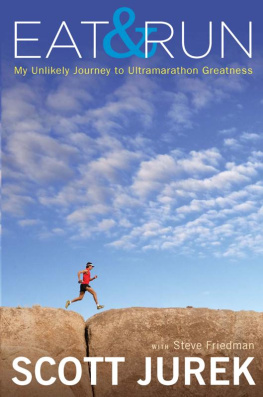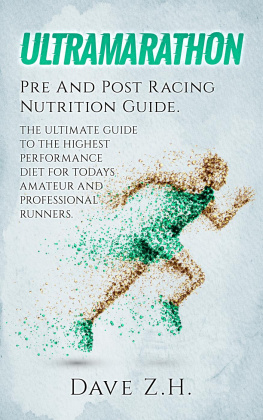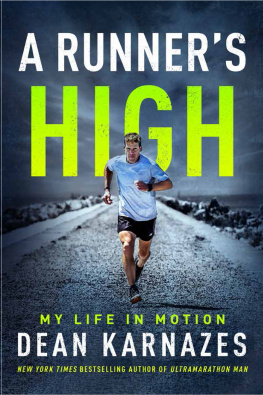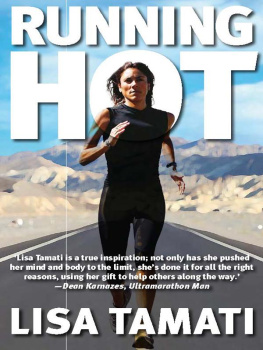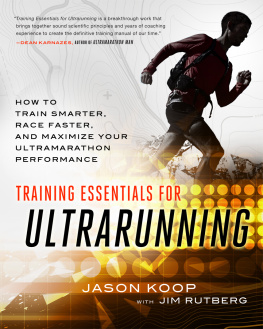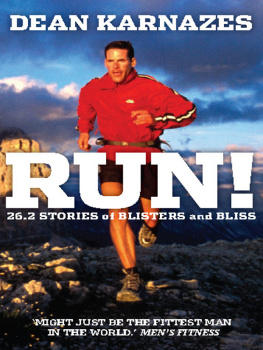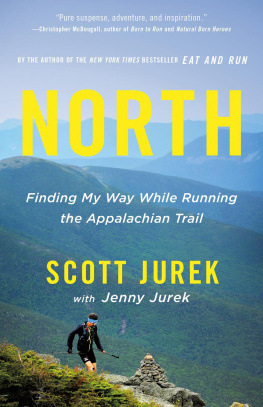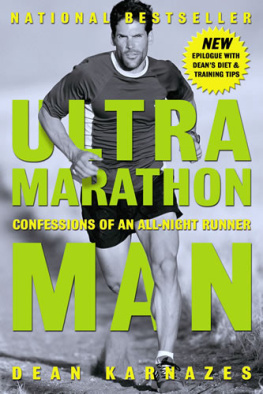A note to the reader:
My book presents my own research and ideas. And while I hope youll be inspired by them to get the most out of yourself, and out of life, keep in mind that Im not a doctor. So by all means use this book, but this book is not intended to substitute for consultation with a doctor or healthcare provider. Neither I nor the publisher can claim any responsibility for any adverse effects resulting directly or indirectly from information contained in this book.
Let me put it another way: If you decide to run 135 miles in Death Valley, no matter what advice of mine you do or do not follow, you do so at your own risk. But Ill be with you in spirit, every kickass step.
Copyright 2012 by Scott Jurek
All rights reserved
For information about permission to reproduce selections from this book, write to Permissions, Houghton Mifflin Harcourt Publishing Company, 215 Park Avenue South, New York, New York 10003.
www.hmhbooks.com
Library of Congress Cataloging-in-Publication Data
Jurek, Scott, date.
Eat and run: my unlikely journey to ultramarathon greatness / Scott Jurek, with Steve Friedman.
p. cm.
Includes index.
ISBN 978-0-547-56965-9
1. Marathon runningTraining. 2. Marathon runningPhysiological aspects. 3. AthletesNutrition. 4. Vegan cooking. I. Friedman, Steve, date. II. Title.
GV1065.17.T73J87 2012
796.42'52dc23 2012010581
Book design by Melissa Lotfy
Printed in the United States of America
DOC 10 9 8 7 6 5 4 3 2 1
To my parents, who first taught me to dig deep, and to all those who taught me to dig deeper
Beyond the very extreme of fatigue and distress, we may find amounts of ease and power we never dreamed ourselves to own; sources of strength never taxed at all because we never push through the obstruction.
WILLIAM JAMES
Prologue
I was a shy kid with high blood pressure. I grew into a skinny adolescent whom other kids teased and called Pee-Wee. I wasnt the fastest kid in my school, or the strongest, or even the smartest. I was common as grass, longing for something I couldnt even name. I was like everyone else, the same. Then I found something.
Im not going to offer gauzy parables about inspiration and belief. Im not going to promise you that if you want to achieve your dream, all you need is faith. No, I am going to show youin concrete termshow I transformed myself from the inside out and how you can do it too. Whether youre a marathoner or weekend jogger, swimmer or cyclist, young or old, fit or fat, you can do this. I know because I did it.
The story of my life is going to sound very familiar. Not in the details (unless youve found yourself face down in Death Valley, that is), but in the desire. Its the tale of everyone who has ever felt stuck, of anyone who has dreamed of doing more, of being more.
I was stuck like that a few years ago in one of the lowest, hottest spots on the planet. Thats where Ill start my story. Thats where Ill start your story.
1. Somebody
BADWATER ULTRAMARATHON, 2005
The best way out is always through.
ROBERT FROST
My brain was on fire. My body was burning up. Death Valley had laid me out flat, and now it was cooking me. My crew was telling me to get up, that they knew I could go on, but I could barely hear them. I was too busy puking, then watching the stream of liquid evaporate in the circle of light from my headlamp almost as fast as it splashed down on the steaming pavement. It was an hour before midnight, 105 incinerating, soul-sucking degrees. This was supposed to be my time. This was the point in a race where I had made a career of locating hidden reservoirs of sheer will that others didnt possess, discovering powers that propelled me to distances and speeds that others couldnt match. But tonight, roasting on the pavement, all I could summon was the memory of a television commercial I had seen as a child. First theres an egg in someones fingers and a voice says, This is your brain. Then the owner of the hand cracks the egg, and as it sizzles and crackles onto a hot skillet, the voice says, And this is your brain on drugs. I saw that image in the scorching nighttime sky. I heard the disembodied voice. But what I thought was: This is my brain on Badwater.
I had just run 70 miles through a place where others had died walking, and I had 65 more to go. I reminded myself that this was the point in the race where I was supposed to dust anyone foolish enough to have kept up with me in the first half. In fact, I had started this race intending to shatter its record, never mind worry about winning it. And now I didnt think I could finish.
There was only one answer: Get up and run. Whatever the problem in my life, the solution had always been the same: Keep going! My lungs might be screaming for oxygen, my muscles might be crying in agony, but I had always known the answer lay in my mind. Tired tendons had begged for rest in other places, my flesh had demanded relief, but I had been able to keep running because of my mind. But not now. What had gone wrong?
Running is what I do. Running is what I love. Running isto a large extentwho I am. In the sport I have chosen as avocation, career, obsession, and unerring but merciless teacher, running is how I answer any challenge.
Technically speaking, I am an ultramarathoner. So I compete in any footrace longer than the marathon distance of 26.2 miles. In point of fact, though, I have fashioned a career from running and winning races of at least 50 miles, most often 100, and every so often 135 and 150 miles. Some I have led from start to finish; in others I have stayed comfortably back until the point when I needed to find another gear. So why was I on the side of the road vomiting, unable to go on?
Never mind my success. People had warned me that this racethis 135-mile jaunt through Death Valleywas too long and that I hadnt given my body enough time to recover from my last racea race I had won just two weeks earlier, the rugged and prestigious Western States 100 Mile. People had said that my dietI had been eating only plant-based foods for seven yearswould never sustain me. No one had voiced what I now suspected might be my real problemthat I had underestimated the race itself.
Some ultras curve through level virgin forest, next to melodious streams, past fields of wildflowers. Some ultras occur in the cool melancholy of autumn, others in the invigorating chill of early spring.
Then there were the ultras like the one that had felled me. Its proper name was the Badwater UltraMarathon. Competitors called it the Badwater 135, and a lot of people knew it as the worlds toughest foot race.
But I hadnt taken such talk too seriously. I thought I had run more difficult courses. I thought I had faced much faster, tougher competition. I had raced in snow and rain, won events in far corners of the earth. I had scrambled up loose rock, over peaks of 14,000 feet. I had hopscotched down boulder fields, forded across icy streams. I was used to trails that caused deer to stumble and falter.
Sure, the Badwater flat-lined through Death Valley at the hottest time of the year. And yes, according to Badwater legend, one year when a shoe company handed out its product to all entrants, many of the soles supposedly melted on the scorching pavement.
But that was just a story, right? And though the Badwater did sizzle and though it was longer than I usually race, its brutality was unidimensional. I was used to forbidding terrain, climate, and competition. Other ultras inspire not just reverence but fear. The Badwater? The truth is, a lot of the most accomplished and well-known ultrarunners had never run it. Yeah, Death Valley made it sound ominous, if not fatal, but among elite ultrarunners, tales of danger and death arent uncommon. Ultrarunners liked the stories but didnt dwell on them. We couldnt.
Next page
